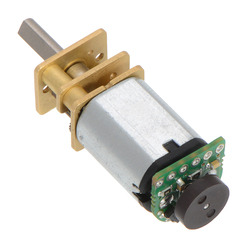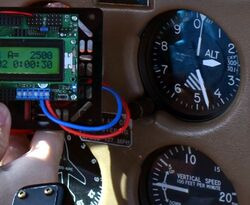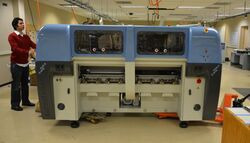Pololu Blog » Engage Your Brain »
Engage Your Brain (Page 6)
A blog by Pololu president Jan Malášek.
On losing my baby
This blog post is about some personal difficulty I’m going through: last month, my baby died unexpectedly a day or two before he was born. I could just collect my thoughts in my private journal, but I am sharing my experience here on the Pololu blog because most of the people I interact with and care about are related to Pololu, be they friends, employees, vendors, or customers. Just about everyone at Pololu knew of my eager anticipation of this new baby, and any visitors were aware that I might miss our meetings with short notice depending on when the baby arrived. Continued…
New products: Magnetic quadrature encoders for micro metal gearmotors
Everyone wants encoders on their motors. If you think you don’t, you just don’t know it yet. I think the main reason is that we really just want motors to do what we tell them to do, but they don’t. One of the most common beginner questions we get is some variation of, “why doesn’t my robot go straight?” or “I got two of the same motor but they do not go the same speed; is something wrong with one of them?” More seasoned robot builders know that since there will always be variations in everything that contributes to a motor’s performance, our best hope is to put a sensor on the motor to monitor what is actually happening and then adjust the motor control to make reality better match our desires. Continued…
Big price reductions and new options for our popular stepper motor drivers
We recently substantially reduced prices on our stepper motor driver carriers, and I figured this announcement was a good time to give you an update on our perspective and capabilities.
It has been over five years since I designed our original stepper motor driver carrier, which was for the A4983 from Allegro. While fairly straightforward, the implementation reflected several design philosophies that go into Pololu products, such as making the boards as small as practical and including the right extra components to make the main chip easily usable without unnecessarily limiting its features. Continued…
Thoughts on journalists checking drafts with sources
I received a phone call yesterday from a writer for a local community-oriented, general-interest publication. Pololu is one of a dozen or so companies she was covering in an article about technology-related companies in southern Nevada, and she asked some basic questions about Pololu and how we might be relevant to Las Vegas-area locals. She then asked if there was anything else I would like to add or have mentioned about us. I answered that since I wasn’t really clear on what this article was going to be or what the intended audience was, I did not know what would be appropriate or interesting. I suggested that she could send me a draft of her article so that I might have a better context for giving her additional info. Continued…
LPS331AP pressure sensor test flight
We expect to release a simple carrier for ST’s new LPS331AP pressure sensor this week. While testing and writing example programs for the sensor, one of our engineers, Kevin, came up with a nice demonstration that calculates and displays the altitude on our Orangutan SVP robot controller. It was a beautiful spring day with great flying weather, so Paul and I took Kevin’s digital altimeter on a flight to Lake Havasu City, Arizona, to see how it compared to the altimeter in a plane. Continued…
More fun machines, part 2
I posted toward the end of last year about some new equipment we were adding to our manufacturing operations and said the best stuff was still coming. I and several others at Pololu have since had some more personal deliveries of the crying-all-night sort, which delayed my promised update. I still do not have the performance information I had hoped to have by now, but let’s at least look at what we got: Continued…
Meeting with Governor's Office of Economic Development
I sort of had a meeting with the governor of Nevada this morning. I’m posting some notes about it mostly for others at Pololu, but maybe it will be interesting to other small businesses in Las Vegas. I probably should have been more prepared for the meeting; I still don’t know much about who was there or what exactly happened or what the stakes were, so a lot of my descriptions are kind of vague. Continued…
More fun machines for us, better quality and lower prices for you
As we head into what is traditionally a week of heavy discounting, I want to give a little update about some new equipment that will be a foundation for our long-term commitment both to lowering prices and increasing the quality and sophistication of our products. Plus, I figure these kinds of machines are fun for our customers to look at. Continued…
Ten years in Las Vegas
Starting with the move from our dorm to an apartment in Watertown, Massachusetts, Pololu has moved or expanded ten times. The most significant was our move to Las Vegas, which represented a commitment to doing this thing for real. This past Sunday was the 10-year anniversary of arriving in Las Vegas, so I figured I should commemorate it by putting up some old pictures. Continued…
Thoughts on Open-Source Hardware
As open-source hardware (OSHW) has become more prominent over the past five years or so, I have heard questions about where I or Pololu stand on the subject. Most recently, I got into a bit of a discussion with Phillip Torrone of Make and Adafruit on one of his blog posts, and his questions and subsequent interview pushed me to try to organize some of my thoughts about OSHW. Because there are many aspects to OSHW, I don’t have a simple conclusion like, “It’s great!” or “It’s the future!” or “Pololu will never release an OSHW product.”. I am skeptical of some of the claims by OSHW proponents and of the significance of the more organized aspects of the OSHW movement. However, what is going on is very significant to me because it affects Pololu’s business and involves issues I care about a lot, such as freedom, creating things, and education. Continued…





















